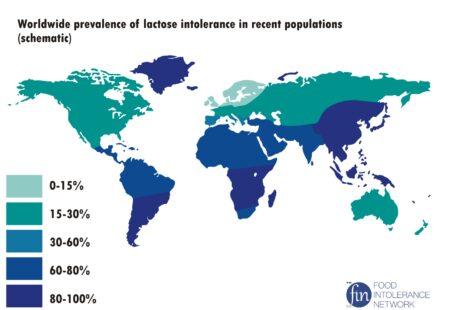A growing aisle and trend
If you haven’t noticed, the dairy aisle just keeps on growing. Back in 2016, the fine economists at Farm Credit Canada (FCC) projected that Canadian yogurt and specialty cheese consumption would increase 21.6% and 9.2% respectively, between 2015 and 2024. Not only is the dairy section of the store stocking more international cheeses, probiotic drinks and many nations’ forms of yogurt, but it’s also expanding to include non-dairy consumers. At the same time, we’re seeing a drop in consumption of fluid milk in the country, which Statista attributed to the 2.3 million vegetarians and 850,000 vegan consumers in Canada. While this might be true, today’s blog is going to ignore this demographic, as the choice to avoid animal products is a bigger topic of ethics, sustainability values, and religion, which is a much longer blog for another time.
Today’s focus is on dairy aisle changes, looking at the growth in products available for us lactose intolerant folks. I LOVE DAIRY PRODUCTS, but my body hates me for indulging in them. Until a few years ago and based on my post-secondary education financial situation, finding good, affordable lactose-free dairy options seemed impossible. I tried the alternatives of milk, like almond, soy, and rice, but none hit the mark for me. Whereas I do love coconut-based frozen treats, but boy, those will break the bank if you become hooked on them.
What is lactose?
For those of you fortunate not know what lactose is, it is the sugar found in milk and its products. The amount of lactose in a product varies by animal, product, and how it’s processed. For example, much of the lactose is lost in cheese production. Lactose intolerance is not an allergy, but instead a body’s inability to digest this sugar. This intolerance is the result of the absence of an enzyme called lactase, which is what our bodies produce to break down lactose. In infancy, newborns rely on milk sources and lactose as a form of energy. Unfortunately, as you age if you happen to be someone with the genetic predisposition or come from a population of reduced dairy intake, the ability to synthesis this enzyme for energy in the small intestine can become more difficult over time. In a meta-analysis published in The Lancet Gastroenterology & Hepatology in 2017, the authors concluded that lactose intolerance globally influences 68% of the population. There is a geographic and ethnic difference as well, in which it appears that those of Nordic descent are the least likely to suffer; as you can see from the graphic below (learn one hypothesis as to why here).

File: Worldwide prevalence of lactose intolerance in recent populations.jpg
Should we consume milk?
Many, none of which is my doctor, have told me that we shouldn’t consume milk as adults. Milk is produced post-delivery, and over time milk production is not enough to sustain a growing child’s diet alone. So logically yes, this statement makes sense, but the reality is that we do have milk and its by-products around the world thanks to cattle, sheep, bison, goats, and camels. There are plenty of benefits to drinking milk, as it is rich in nutrition that our bodies need. The Dairy Farmers of Canada report that in cup of 2% milk, you could obtain 27.5% of your daily intake of calcium and 9 g of protein. Not to forget all the micronutrient and added vitamins of milk; of your daily intake, a cup of Dairyland’s 2% milk accounts for Vitamins A (10%), D (45%), B12 (45%), as well as offering a number of other vitamins. Whether we should or shouldn’t consume dairy is not the point of this blog as it’s clearly a great source of nutrition there is no doubt about that. This blog is about what is available for those of us who can’t process dairies lactose and want dairy products.
What are your alternatives to lactose dairy goodness?
The market for lactose-free goods has grown, and in some cases, it has granted access to dairy and others have redefined the use of dairy terms. For some of us, we can brave small amounts of lactose rich foods thanks to the help of lactase enzyme pills. This particular enzyme, which my body does not seem to have to process lactose, can be brought over the counter and helps to break down the annoying lactose for you. It’s a fairly inexpensive solution, yet it has its limits.
There are of course your alternative ‘dairy’ products that have evolved from soymilk to products like milk made of almonds, peas and oat, vegan cheeses, and other plant-based innovations that use the dairy terminology of cheese, cream, and milk. In 2020 the dairy alternative market was valued at $22.6 Billion USD and in six years is expected to nearly double to $40.6 Billion. There is a demand for these alternative products, but in my opinion, they are still not on equal par with dairy products.
Thankfully, for me, there has been an increase in lactose-free dairy items and a decrease in price (by half). Just in recent years, lactose-free options gained their shelf space in the market to include milk of different fat percentages, carton size, flavour, as well as cheeses, creams (sour, coffee and whipping), ice creams, and butter. Not to mention, it’s not just one firm in the small and very exclusive Canadian dairy club. While it used to just be Natrel and Lactantia, in Western Canada, Neilson, Dairyland, and Fairlife have joined the club, and Joyya milk is ultrafiltered to have 25% less lactose. Outside of fluid milk, more and more products pop up including yogurts from big names like Liberte and Danone (Light & Free has reduced lactose), Loblaw’s has a selection of products President’s Choice cheeses and sour cream, Chapman’s makes ice creams, Philadelphia offers a lactose-free cream cheese, and the list goes on.
Innovations involved in going lactose-free
To produce a lactose-free product, there are a few methods. The most common way is to add the lactase enzyme to a pasteurized milk, and once the lactose is removed, it then has to be re-pasteurized. This is typically how dairies produced lactose-free products; it’s this extra step that ends up raising the price. It has been the innovation and introduction of ultrafiltration that has helped bring greater volumes of lactose-free products to market and at a lower price point. Ultrafiltration is a hydrolysis system where milk is pushed through a fine membrane/filter separating milk lactose, water, and some mineral from the fat and protein of the milk. This filtered milk can be treated with lactase if needed, but at a lower quantity than without. Because of this ultrafiltration, the milk remaining has less sugar (that is what lactose is) and has a higher percentage of protein per volume than unfiltered milk. While the milk may be originally processed to reduce the lactose, it’s being marketed as ‘healthier’ milk with its higher percentage of protein and lower sugar, which is just the reduction of lactose.
It’s not my position to suggest you should buy lactose-free foods if you don’t need them, or that you should try out the alternatives of ‘dairy’. Instead, I wanted to highlight one way in which the dairy aisle is changing, being more inclusive, and innovating. As we see our grocery aisles and products evolve, what products or innovations do you hope to see on the shelves shortly? As I eluded in a past blog, I hope to see the return of the Vi-Co cartons, but which are lactose-free so I can relive my childhood memories without the pain and suffering of lactose.

